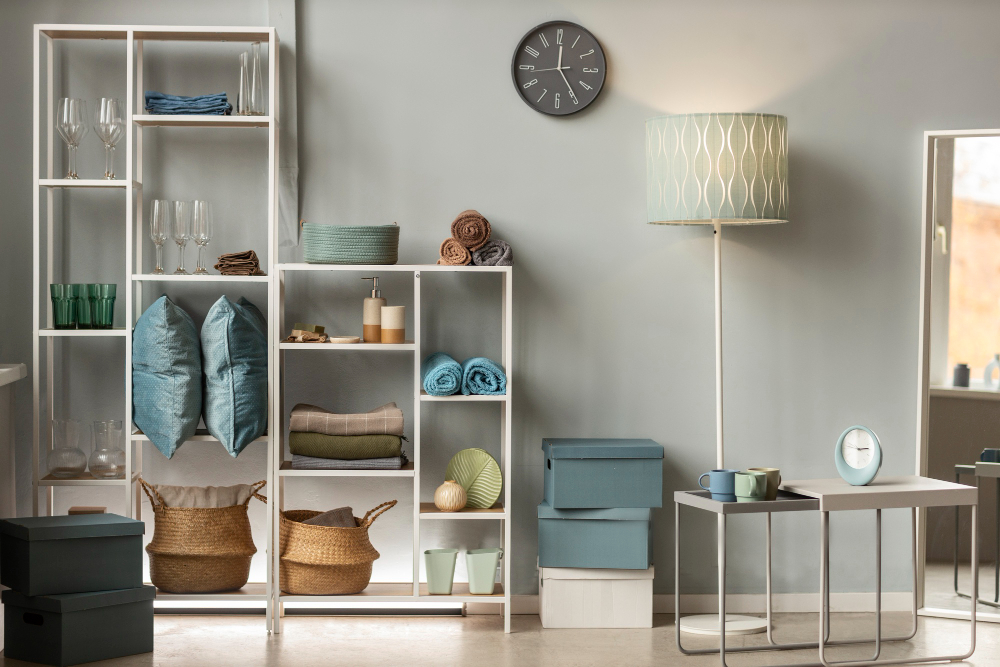

Moving into a compact apartment doesn't mean sacrificing style or functionality. With the right design strategies, even the smallest spaces can feel open, organized, and uniquely yours. These proven techniques will help you transform any cramped quarters into a comfortable, visually appealing home that maximizes every square foot.
Smart furniture selection forms the foundation of effective small space design. Ottoman storage benches provide seating while hiding clutter. Nesting tables offer surface space when needed but tuck away to save room. Dining tables with built-in drawers keep linens and utensils within reach without requiring additional storage furniture.
Sleeper sofas serve double duty as living room seating and guest accommodation. Wall-mounted desks fold down when needed for work, then disappear to free up floor space. These versatile pieces eliminate the need for separate items, reducing visual clutter while maintaining functionality.
Pulling furniture away from walls creates the illusion of more space. A sofa positioned in the center of a room with a narrow console table behind it defines separate zones without blocking sight lines. This technique works particularly well in studio apartments where you need to create distinct living areas.
Floating furniture also improves traffic flow. Instead of pushing everything against the perimeter, strategic placement allows people to move naturally through the space. This approach makes rooms feel larger and more inviting.
Tall bookshelves, cabinets, and wardrobes draw the eye upward, creating the perception of height. Custom built-ins or well-chosen retail pieces that reach the ceiling provide maximum storage while maintaining clean lines. Use the highest shelves for items you access less frequently.
Vertical storage solutions work especially well in bedrooms and home offices. Floor-to-ceiling closet organizers double hanging space, while tall bookcases can house everything from books to decorative objects without overwhelming the room.
Wall-mounted shelves provide storage and display space without consuming floor area. Install them above doorways, in unused corners, or along hallways to create functional storage throughout your home. Group shelves at varying heights to create visual interest while maintaining practicality.
Floating shelves work particularly well in kitchens, where they can hold dishes, spices, and cookbooks. In living areas, they provide space for books, plants, and decorative items without requiring bulky bookcases.
Light, neutral colors reflect more light and make spaces appear larger. White, cream, soft gray, and pale pastels create an airy atmosphere that expands visual boundaries. This doesn't mean your space needs to be boring—add personality through textures, patterns, and strategic accent colors.
Paint walls, ceilings, and trim in similar light shades to blur boundaries and create seamless flow. This technique eliminates visual breaks that can make small spaces feel choppy and confined.
Multiple light sources create depth and eliminate harsh shadows that can make spaces feel smaller. Combine overhead lighting with table lamps, floor lamps, and wall sconces to create a warm, inviting atmosphere. Each light source should serve a specific purpose while contributing to the overall ambiance.
Under-cabinet lighting in kitchens and LED strips behind furniture add subtle illumination that makes spaces feel more open. Dimmer switches allow you to adjust lighting throughout the day, creating different moods in the same compact space.
Mirrors reflect light and create the illusion of additional space. Place a large mirror opposite a window to bounce natural light throughout the room. Mirrored closet doors or a gallery wall of smaller mirrors can double the apparent size of a space.
Avoid placing mirrors directly across from each other, which creates a disorienting infinite reflection. Instead, angle mirrors to reflect attractive views or architectural features you want to emphasize.
Mirrored coffee tables, nightstands, and console tables provide necessary surfaces while maintaining visual lightness. These pieces reflect surrounding colors and textures, helping them blend seamlessly into small spaces without adding visual weight.
Every piece of furniture should work harder in a small space. Beds with built-in drawers, storage ottomans, and coffee tables with hidden compartments keep belongings organized without adding clutter. These solutions maintain clean lines while providing essential storage.
Look for unexpected storage opportunities throughout your home. The space under stairs, above cabinets, and inside furniture pieces can accommodate items you need but don't use daily.
Open shelving units, curtains, and folding screens can separate different areas without blocking light or making spaces feel smaller. These dividers create defined zones for sleeping, working, and relaxing while maintaining the open feel essential in compact living.
Choose dividers that serve multiple purposes. A bookshelf room divider provides storage while creating separation. A curtain can hide a home office area when not in use, then open to integrate the space with the main room.
Horizontal stripes, whether in wallpaper, artwork, or furniture design, make rooms appear wider. This technique works particularly well in narrow spaces like hallways or galley kitchens. Horizontal paneling or strategically placed artwork can create the illusion of expanded width.
Furniture with legs allows you to see the floor beneath, creating an uninterrupted visual flow that makes spaces feel larger. Choose sofas, chairs, and tables that sit off the ground rather than pieces that touch the floor completely.
Glass and acrylic furniture pieces maintain functionality while appearing nearly invisible. These materials don't interrupt sight lines, helping maintain the open feel essential in small spaces.
If your apartment includes a balcony or patio, treat it as an extension of your indoor living space. Use similar colors and materials to create continuity between inside and outside. Outdoor furniture that complements your interior design makes the transition seamless.
Even small balconies can become functional outdoor rooms with the right furniture and accessories. Folding chairs, stackable stools, and rail-mounted planters maximize functionality without overwhelming the space.
The most effective small space design hack is simply owning less. Regular decluttering ensures every item in your home serves a purpose and contributes to your overall design vision. Adopt the "one in, one out" rule to prevent accumulation.
Focus on quality over quantity when selecting furniture and accessories. A few well-chosen pieces will have more impact than numerous smaller items that create visual chaos.
One or two larger statement pieces often work better than many smaller decorative items. A single piece of artwork, a beautiful lamp, or an interesting chair can provide personality without overwhelming the space.
Small space living requires creativity, but the results can be both stylish and functional. These design strategies work whether you're furnishing a studio apartment or trying to make a one-bedroom feel more spacious. The key is choosing solutions that serve multiple purposes while maintaining the clean, uncluttered aesthetic essential for successful small space design.
Remember that great design is about making conscious choices that reflect your lifestyle and preferences. Start with one or two techniques that appeal to you most, then gradually incorporate additional strategies as you discover what works best for your specific space and needs.
If you're looking for apartments for rent in Columbia, SC, contact Otarre Pointe Apartments today to schedule a personal tour.